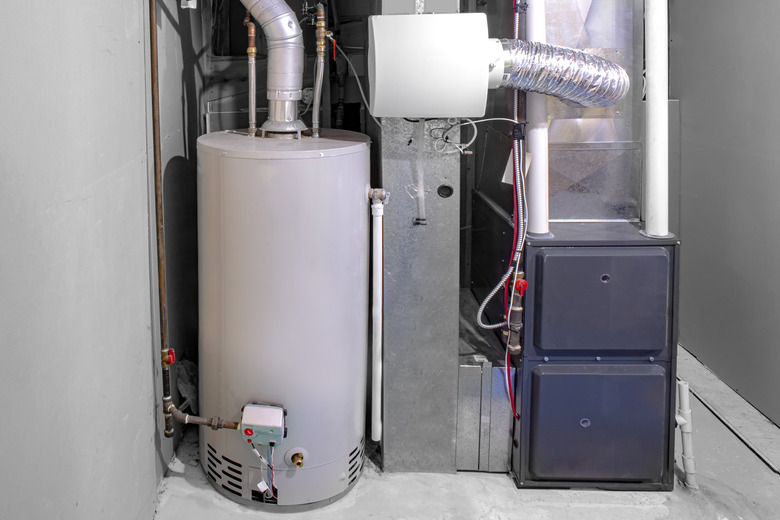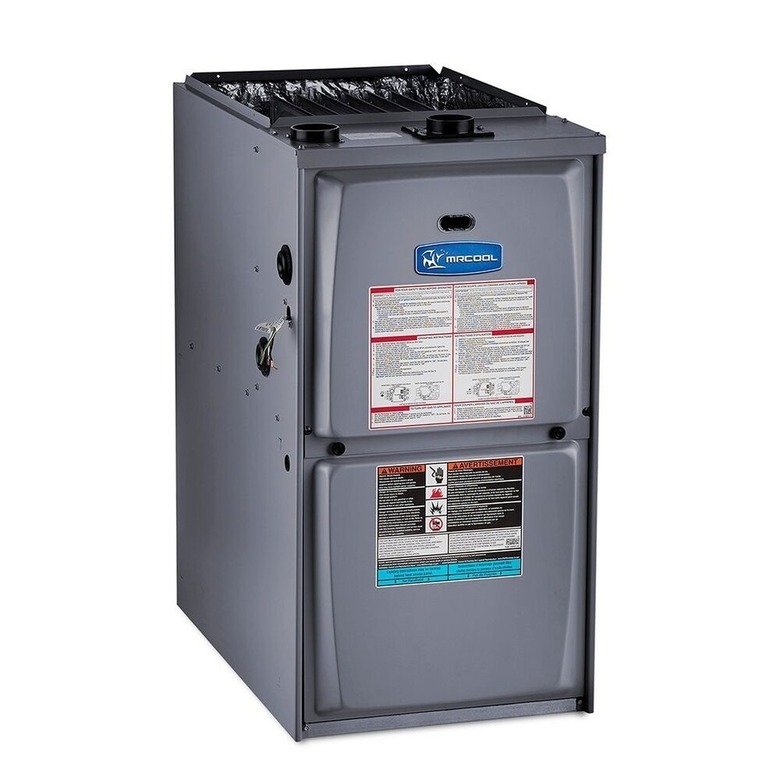Is A High-Efficiency Furnace Worth It?
We may receive a commission on purchases made from links.
Buying a new furnace is a costly endeavor, and if you're in the market for a high-efficiency furnace, expect to spend up to twice as much as you would on the average conventional furnace with midrange efficiency. On the upside, higher efficiency requires less fuel to create heat, which means lower heating costs and fewer carbon emissions for individual homeowners. Whether it's worthwhile to invest in a high-efficiency furnace depends on the climate as well as the size of your home and how long you plan to stay in it.
Tip
A high-efficiency furnace is worth the higher price if you plan to stay in the home a long time — and if you live in a climate with cold winters.
Upfront Furnace Costs
Upfront Furnace Costs
The average high-efficiency furnace, also called a condensing furnace, costs more to buy and install than the average conventional noncondensing furnace. The upfront costs of a residential high-efficiency furnace runs anywhere from $3,000 to more than $12,000, which includes installation. The average midrange efficiency model, including installation, costs $1,500 to $3,000. The more energy efficient the furnace is, the more complex, which factors into the cost.
If this is the first high-efficiency furnace for your home, installing some new vents and ductwork may result in additional installation and labor costs. New furnaces often have higher cubic-feet-per-minute (CFM) airflow requirements than older models, so any old ductwork must be able to handle the higher airflow or else it's replaced. Adding new vents to your home may also increase the labor cost to ensure the venting meets current standards and regulations. For best results in receiving an accurate installation quote, ask a representative of the HVAC installation company to visit your home and assess any existing ductwork and furnace vent pipes.
AFUE Ratings Explained
AFUE Ratings Explained
Much the way a car's gas usage or efficiency is listed in miles per gallon (MPG), a gas furnace's operating cost is measured by annual fuel utilization efficiency, or AFUE. A car with a high MPG rating has high fuel efficiency, meaning you'll spend less on gas usage than if you drive the same distance in a car with low MPG. Likewise, a furnace with a high AFUE rating costs less to operate than a furnace with a lower AFUE rating.
To be considered a high-efficiency furnace, the AFUE rating is at least 90 percent or generally 90 to 97 percent, though some models may have efficiency above 98 percent. By comparison, a midefficiency furnace has an 80 to 85 percent AFUE rating. A furnace with an 80 percent AFUE rating utilizes 80 percent of its energy source to heat the home, while the other 20 percent is lost up the chimney as wasted heat. AFUE does not account for energy or heat lost through ductwork.
Older furnaces are almost always less efficient, with average AFUE ratings from 56 to 70 percent. The required minimum standard for new gas furnaces sold since 2015 is 80 percent.
Annual Furnace Operating Costs
Annual Furnace Operating Costs
The annual fuel usage and cost to heat a home vary depending on the home size, fluctuating fuel-energy costs, the amount of chilly weather in any given year and how well the house is insulated. Even with such variables, heating-fuel usage over time in the average climate with heater-worthy winters helps determine what you might spend to heat your home with any type of furnace. For a 2,000-square-foot home, the average energy-efficient furnace uses about $545 in fuel annually based on national average fuel costs and averaged temperatures. If you stay in the same home with the same furnace for 20 years, that's nearly $11,000 to operate the furnace. A gas furnace usually lasts anywhere from 15 to 30 years.
By comparison, the average furnace that's not a high-efficiency model uses $715 in fuel per year to heat the same house size in the same climate, or more than $14,000 over 20 years. Furnaces that use electricity instead of gas cost even more to operate — about $1,800 annually. Using these numbers, converting from a mid to high-efficiency gas furnace means a savings of $170 in annual heating costs. At $170 in savings per year, a $3,000 high-efficiency furnace pays for itself in 18 years, but if you compare it to purchasing a $1,500 midrange furnace, it takes nine years to make up the difference, and the rest is all savings.
If you're converting from an inefficient, old furnace, the annual savings goes up significantly, which also means the extra cost of the furnace pays for itself quicker. A high-efficiency furnace could cost up to 30 percent less to operate each year compared to a furnace with a low AFUE rating, such as 65 percent. The colder your climate and the more often you heat the home, the more significant the potential savings over time. If your region is cold enough to use the heater for six months of the year and you have cold, blustery winters, a furnace with better energy efficiency could well be worth the cost.
Furnaces and Carbon Footprint
Furnaces and Carbon Footprint
Using less fuel to heat your home also means you're reducing the greenhouse gases emitted into the atmosphere by your furnace. Upgrading from a 56 percent AFUE rating to a 90 percent AFUE rating cuts carbon dioxide emissions by about 1.5 tons in just one year in a climate with cold winters. The average residential high-efficiency furnace emits about 3.5 tons of carbon dioxide per year (compared to 4.5 tons for any gas furnace that isn't a high-efficiency model). Homes with electric furnaces emit even more carbon dioxide at a whopping 9.5 tons per year.
As a whole, each home in the United States emits anywhere from 19 to 91 tons of greenhouse gases per year, including carbon dioxide, or about five times as much as any other country in the world. The average per home overall is 48 tons per year. The carbon footprint measures greenhouse gases resulting from everyday activities, such as cooking, driving or running appliances. The average carbon footprint per person in the U.S. is 16 tons per year compared to 4 tons per year elsewhere on the planet. A high-efficiency furnace can help improve an individual or a home's carbon footprint.
Other Furnace-Purchase Factors to Consider
Other Furnace-Purchase Factors to Consider
One factor determining whether it is worthwhile to invest in a high-efficiency furnace is how long you plan to spend in the home. If you plan to move in a couple years, it may not be worth the extra expense, but if you're in it for the long haul, it's a worthy investment. Upgrading your furnace's efficiency may also net some federal tax credits as well as regional utility incentives or rebates depending on current offerings in your area. If you keep your home temperature hotter than other homes in the neighborhood in the winter, the added energy savings could significantly cut your energy bills. Conversely, if you don't use the heater much or keep the temperature quite cool, the savings difference won't be as great when comparing mid and high-efficiency furnace usage.
Costs for some repairs also run higher for high-efficiency furnaces. While the average maintenance cost for any gas furnace runs around $300, replacing a control board could cost $600 or more on a high-efficiency furnace compared to $200 to $400 for the typical midefficiency furnace. Expect to pay for some maintenance, cleaning or a checkup every few years no matter which type of furnace you own.
If you're doing your best to reduce the carbon footprint in your home and your furnace is outdated and inefficient, a newer gas furnace is healthier for the environment.
References
- Lennox: Annualized Fuel Utilization Efficiency (AFUE)
- Trane: What Does AFUE Stand For?
- Appliance Standards Awareness Project: Furnaces
- United States Department of Energy: Furnaces and Boilers
- FortisBC: High Effieciency Furnace Installation Guide for Existing Houses
- Intuit: Energy Tax Credit: Which Home Improvements Qualify?
- PBS: 5 Charts Show How Your Household Drives Up Global Greenhouse Gas Emissions
- The Nature Conservancy: Calculate Your Carbon Footprint
- HomeAdvisor: How Much Does Furnace Cleaning or Repair Cost?

